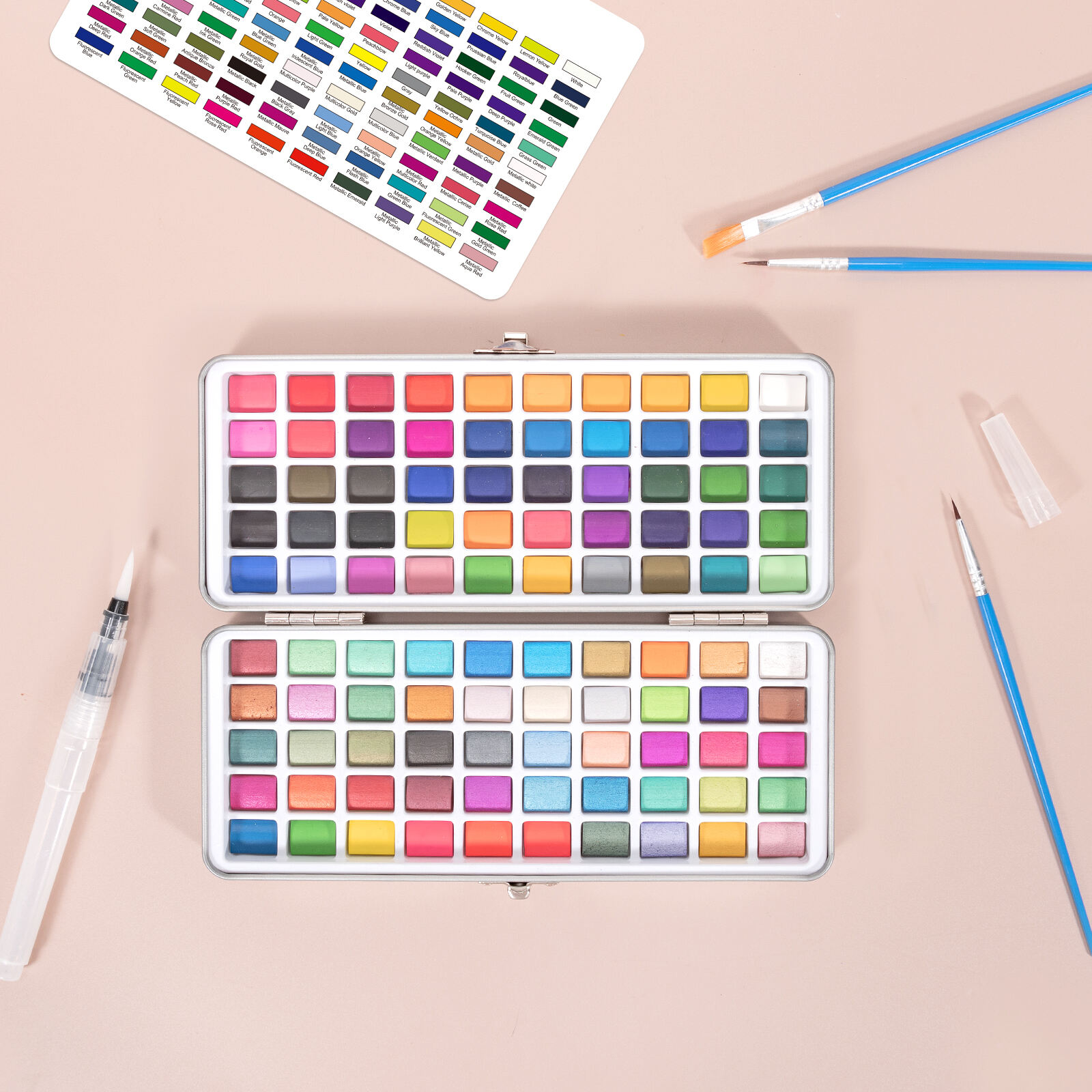Opnå professionelle resultater med markører
Markører er et af de mest alsidige og populære værktøjer inden for kunst og design. De muliggør levende farver, præcise linjer og jævn farveblanding, hvilket gør dem ideelle for kunstnere, illustratører og designere. Men at opnå professionelle resultater med markører kræver mere end blot talent. Korrekt valg, håndtering og vedligeholdelse af markører spiller en afgørende rolle for at skabe kvalitetsfuld kunst. Virksomheder som Shanghai Haobin Stationery & Art Material Co., Ltd. tilbyder et bredt udvalg af kunstmarkører og professionelle markører, så kunstnere har adgang til værktøjer, der fremmer kreativitet og præcision. Ved at forstå almindelige fejl og hvordan man undgår dem, kan kunstnere få mest muligt ud af deres markører og forbedre kvaliteten af deres arbejde.
Forståelse af grundlæggende om markører
Valg af de rigtige markører til dine projekter
Alle markører er ikke skabt lige. Professionelle markører giver levende farver, jævn blækstrøm og holdbare spidser, der tåler gentagen brug. At vælge de rigtige markører til dit specifikke projekt kan markant forbedre din arbejdsgang. Kunstmarkører findes i mange forskellige typer, herunder alkoholbaserede, vandbaserede og hybridmarkører, hvor hver enkelt er egnet til forskellige teknikker og overflader. At vælge markører af høj kvalitet fra anerkendte leverandører sikrer pålidelig præstation og forbedrer det samlede resultat af dit kunstværk.
Forberedelse af arbejdspladsen til brug af markører
Et veludforsket arbejdsområde er afgørende, når der arbejdes med markører. At sikre korrekt belysning, en jævn tegneoverflade og nem adgang til alle værktøjer hjælper med at forhindre almindelige fejl som udsmudging eller ujævn farvefordeling. Kunstnere vurderer ofte betydningen af et organiseret arbejdsområde for kvaliteten af deres arbejde for lavt. Ved at placere markører, papirer og andet tegneudstyr overvejet, kan man koncentrere sig mere om kreativitet og mindre om utilsigtede hændelser eller uheld.
Forståelse af markørteknikker
Professionelle markørteknikker inkluderer blanding, lagdeling, skyggevirkning og detaljering. Kunstmarkører giver glatte overgange og levende farveeffekter, når de bruges korrekt. Nybegyndere har ofte problemer med ujævn blanding eller strejf, hvilket kan undgås ved at mestre grundlæggende markørteknikker. Det er afgørende at forstå, hvordan blæk interagerer med forskellige papertyper, og hvordan man kontrollerer pres og strøgestyring for at opnå ensartede og professionelle resultater.
Almindelige fejl og hvordan man undgår dem
Overlappende farver uden planlægning
En almindelig fejl er at overlægge farver uden at planlægge rækkefølgen. Dette kan resultere i mudrede farver og ujævn blanding. Korrekt lagdeling indebærer at starte med lyse farver og gradvist tilføje mørkere nuancer, hvilket giver glatte overgange. Brug af professionelle markører, der er designet til blanding, gør processen nemmere og mere forudsigelig. Omhyggelig planlægning sikrer, at det endelige værk bibeholder klarhed og livagtighed.
Anvendelse af for stort tryk
At anvende for stort tryk på markører kan beskadige spidserne og skabe uregelmæssige linjer. Kunstmarkører er designet til at yde optimalt under moderat tryk, så blæk flyder jævnt, mens spidsens integritet bevares. For stort tryk kan også føre til, at blæk siver igennem papiret, hvilket nedsætter kvaliteten af dit arbejde. At lære at kontrollere håndtrykket og træne ensartede strøg er afgørende for at bevare både markørerne og tegningernes kvalitet.
At ignorere markørvedligeholdelse
At negligere vedligeholdelse er en anden almindelig fejl. Markører kræver korrekt opbevaring, såsom at holde kapperne stramt lukkede og opbevare dem vandret for visse typer. Dette forhindrer spidserne i at tørre ud eller blive misformet. At rengøre spidserne af og til og tjekke farvekonsistensen sikrer, at professionelle markører yder pålideligt over tid. Korrekt vedligeholdelse forlænger markørernes levetid og forbedrer konsistensen af resultaterne på tværs af projekter.
Øg kreativitet med professionelle markører
Eksperimentering med lagdeling og blanding
Professionelle markører giver kunstnere mulighed for at udforske avancerede teknikker som lagdeling og blanding. Ved strategisk at kombinere farver kan kunstnere skabe dybde, struktur og dynamisk skygning i deres værker. Kunstmarkører er designet til at blande sømløst, hvilket gør det nemmere at opnå subtile gradienter og komplekse effekter. At eksperimentere med disse teknikker forbedrer den kunstneriske udtryksform og muliggør mere sofistikerede og polerede resultater.
Kombinere markører med andre tegneudstyr
Markeringer fungerer bedst, når de bruges sammen med komplementære kunstmaterialer. Kombinerer du f.eks. markeringer med farveblyanter, penne eller endda vandfarver, kan du opnå unikke effekter og give dit kunstværk mere dybde. Leverandører, der tilbyder et bredt udvalg af kunstmaterialer, gør det muligt for kunstnere at udforske forskellige teknikker og medier, hvilket fremmer kreativitet og færdighedsudvikling. Ved korrekt integration af markeringer med andre værktøjer øges alsidigheden og de kunstneriske muligheder udvides.
Sådan vælger du pålidelige leverandører af kunstmarkeringer
At vælge en pålidelig leverandør sikrer konstant kvalitet og adgang til professionelle markeringspenner. Virksomheder som Shanghai Haobin Stationery & Art Material Co., Ltd. leverer højkvalitets kunstmarkere, professionelle markeringspenner og en række værktøjer, der er skræddersyet til kunstneres behov. Direkte fabriksforsyning sikrer kvalitetskontrol fra produktion til færdigt produkt og giver kunstnere tillid til deres værktøjer. Samarbejde med pålidelige leverandører muliggør både standard- og tilpassede markeralternativer, som understøtter langsigtede kreative projekter.

Bedste praksis for håndtering af markeringspenner
Opbevaring af markeringspenner korrekt
Korrekt opbevaring er afgørende for at opretholde markørernes ydeevne. Nogle markører skal opbevares vandret for at forhindre at bleget adskilles, mens andre skal holdes lodret for at beskytte spidsen. Sørg altid for, at lågene er sikkert lukket for at forhindre tørring. At opbevare markører i en organiseret æske forhindrer også skader og gør det lettere at vælge den rigtige farve, når det er nødvendigt. Korrekt opbevaring forlænger markørernes levetid og sikrer en jævn blægstrøm.
Rengøring og bevaring af markørspidser
Markørspidser kan samle sig af affaldsstoffer eller blive sliddede med tiden. Ved at rengøre spidserne forsigtigt og undgå ru kanter, opretholdes præcision og jævne linjer. For markører med dobbelte spidser sikrer skiftevis brug af den fine og brede ende en jævn slidage. At bevare spidskvaliteten er afgørende for detaljeret arbejde og muliggør skarpe linjer, jævn skygning og resultater af professionel kvalitet.
Effektiv arbejdsgang med markører
At vedligeholde et organiseret sæt markører forbedrer arbejdseffektiviteten. At gruppere efter farvefamilier, mærke og organisere værktøjer inden for rækkevidde gør det muligt at vælge hurtigere og skifte mere sikkert under tegning. En effektiv arbejdsgang reducerer fejl og giver kunstnere mulighed for at fokusere på kreativitet frem for tekniske forstyrrelser, hvilket i sidste ende forbedrer kvaliteten og konsistensen af deres kunstværker.
Ofte stillede spørgsmål
Hvilke typer markører er bedst til nybegyndere?
Nybegyndere bør starte med et grundlæggende sæt professionelle markører eller tegnemarkører, som tilbyder levende farver og jævn blækstrøm. Alkoholbaserede markører er ideelle til at blande, mens vandbaserede markører giver nemmere rengøring. Et godt valgt start sæt giver nybegyndere mulighed for at øve sig i grundlæggende teknikker uden frustration.
Hvordan kan jeg forhindre, at markørerne tørrer ud?
For at forhindre tørring skal du altid sikre, at kapperne er stramt lukkede efter brug, og opbevare markørerne i henhold til producentens anvisninger. Nogle markører yder bedst, når de opbevares vandret, mens andre bør stå lodret. Undgå at udsætte markører for varme eller direkte sollys, da dette kan påvirke blækets kvalitet.
Kan markører bruges sammen med andet tegneudstyr?
Ja, markører kan kombineres med farveblyanter, penne, akvarel og andre materialer. Denne kombination giver kunstnere mulighed for at skabe strukturer, forøge dybdevirkning og frembringe unikke effekter. Ved at bruge professionelle markører sammen med andet tegneudstyr udvides de kreative muligheder og forbedres kvaliteten af værkerne.
Hvordan opretholder jeg ensartet farve, når jeg lægger markører oven på hinanden?
Opnåelse af konsekvent farve kræver en god planlægning af lag, hvor man starter med lyse nuancer og gradvist tilføjer mørkere toner. Brug af højkvalitets professionelle markører sikrer jævn blækstrøm og forhindrer strejfning. Træning af trykstyring og strøgestrategi hjælper med at opnå jævn overtoning og ensartede resultater.


